Chenshu Wu
ASE: Practical Acoustic Speed Estimation Beyond Doppler via Sound Diffusion Field
Dec 28, 2024Abstract:Passive human speed estimation plays a critical role in acoustic sensing. Despite extensive study, existing systems, however, suffer from various limitations: First, previous acoustic speed estimation exploits Doppler Frequency Shifts (DFS) created by moving targets and relies on microphone arrays, making them only capable of sensing the radial speed within a constrained distance. Second, the channel measurement rate proves inadequate to estimate high moving speeds. To overcome these issues, we present ASE, an accurate and robust Acoustic Speed Estimation system on a single commodity microphone. We model the sound propagation from a unique perspective of the acoustic diffusion field, and infer the speed from the acoustic spatial distribution, a completely different way of thinking about speed estimation beyond prior DFS-based approaches. We then propose a novel Orthogonal Time-Delayed Multiplexing (OTDM) scheme for acoustic channel estimation at a high rate that was previously infeasible, making it possible to estimate high speeds. We further develop novel techniques for motion detection and signal enhancement to deliver a robust and practical system. We implement and evaluate ASE through extensive real-world experiments. Our results show that ASE reliably tracks walking speed, independently of target location and direction, with a mean error of 0.13 m/s, a reduction of 2.5x from DFS, and a detection rate of 97.4% for large coverage, e.g., free walking in a 4m $\times$ 4m room. We believe ASE pushes acoustic speed estimation beyond the conventional DFS-based paradigm and will inspire exciting research in acoustic sensing.
Unfolding Target Detection with State Space Model
Oct 30, 2024



Abstract:Target detection is a fundamental task in radar sensing, serving as the precursor to any further processing for various applications. Numerous detection algorithms have been proposed. Classical methods based on signal processing, e.g., the most widely used CFAR, are challenging to tune and sensitive to environmental conditions. Deep learning-based methods can be more accurate and robust, yet usually lack interpretability and physical relevance. In this paper, we introduce a novel method that combines signal processing and deep learning by unfolding the CFAR detector with a state space model architecture. By reserving the CFAR pipeline yet turning its sophisticated configurations into trainable parameters, our method achieves high detection performance without manual parameter tuning, while preserving model interpretability. We implement a lightweight model of only 260K parameters and conduct real-world experiments for human target detection using FMCW radars. The results highlight the remarkable performance of the proposed method, outperforming CFAR and its variants by 10X in detection rate and false alarm rate. Our code is open-sourced here: https://github.com/aiot-lab/NeuroDet.
USpeech: Ultrasound-Enhanced Speech with Minimal Human Effort via Cross-Modal Synthesis
Oct 29, 2024



Abstract:Speech enhancement is crucial in human-computer interaction, especially for ubiquitous devices. Ultrasound-based speech enhancement has emerged as an attractive choice because of its superior ubiquity and performance. However, inevitable interference from unexpected and unintended sources during audio-ultrasound data acquisition makes existing solutions rely heavily on human effort for data collection and processing. This leads to significant data scarcity that limits the full potential of ultrasound-based speech enhancement. To address this, we propose USpeech, a cross-modal ultrasound synthesis framework for speech enhancement with minimal human effort. At its core is a two-stage framework that establishes correspondence between visual and ultrasonic modalities by leveraging audible audio as a bridge. This approach overcomes challenges from the lack of paired video-ultrasound datasets and the inherent heterogeneity between video and ultrasound data. Our framework incorporates contrastive video-audio pre-training to project modalities into a shared semantic space and employs an audio-ultrasound encoder-decoder for ultrasound synthesis. We then present a speech enhancement network that enhances speech in the time-frequency domain and recovers the clean speech waveform via a neural vocoder. Comprehensive experiments show USpeech achieves remarkable performance using synthetic ultrasound data comparable to physical data, significantly outperforming state-of-the-art ultrasound-based speech enhancement baselines. USpeech is open-sourced at https://github.com/aiot-lab/USpeech/.
RFBoost: Understanding and Boosting Deep WiFi Sensing via Physical Data Augmentation
Oct 04, 2024Abstract:Deep learning shows promising performance in wireless sensing. However, deep wireless sensing (DWS) heavily relies on large datasets. Unfortunately, building comprehensive datasets for DWS is difficult and costly, because wireless data depends on environmental factors and cannot be labeled offline. Despite recent advances in few-shot/cross-domain learning, DWS is still facing data scarcity issues. In this paper, we investigate a distinct perspective of radio data augmentation (RDA) for WiFi sensing and present a data-space solution. Our key insight is that wireless signals inherently exhibit data diversity, contributing more information to be extracted for DWS. We present RFBoost, a simple and effective RDA framework encompassing novel physical data augmentation techniques. We implement RFBoost as a plug-and-play module integrated with existing deep models and evaluate it on multiple datasets. Experimental results demonstrate that RFBoost achieves remarkable average accuracy improvements of 5.4% on existing models without additional data collection or model modifications, and the best-boosted performance outperforms 11 state-of-the-art baseline models without RDA. RFBoost pioneers the study of RDA, an important yet currently underexplored building block for DWS, which we expect to become a standard DWS component of WiFi sensing and beyond. RFBoost is released at https://github.com/aiot-lab/RFBoost.
* Proc. ACM Interact. Mob. Wearable Ubiquitous Technol. 8, 2, Article 58 (June 2024), 26 pages
RF-Diffusion: Radio Signal Generation via Time-Frequency Diffusion
Apr 14, 2024Abstract:Along with AIGC shines in CV and NLP, its potential in the wireless domain has also emerged in recent years. Yet, existing RF-oriented generative solutions are ill-suited for generating high-quality, time-series RF data due to limited representation capabilities. In this work, inspired by the stellar achievements of the diffusion model in CV and NLP, we adapt it to the RF domain and propose RF-Diffusion. To accommodate the unique characteristics of RF signals, we first introduce a novel Time-Frequency Diffusion theory to enhance the original diffusion model, enabling it to tap into the information within the time, frequency, and complex-valued domains of RF signals. On this basis, we propose a Hierarchical Diffusion Transformer to translate the theory into a practical generative DNN through elaborated design spanning network architecture, functional block, and complex-valued operator, making RF-Diffusion a versatile solution to generate diverse, high-quality, and time-series RF data. Performance comparison with three prevalent generative models demonstrates the RF-Diffusion's superior performance in synthesizing Wi-Fi and FMCW signals. We also showcase the versatility of RF-Diffusion in boosting Wi-Fi sensing systems and performing channel estimation in 5G networks.
NeurIT: Pushing the Limit of Neural Inertial Tracking for Indoor Robotic IoT
Apr 13, 2024Abstract:Inertial tracking is vital for robotic IoT and has gained popularity thanks to the ubiquity of low-cost Inertial Measurement Units (IMUs) and deep learning-powered tracking algorithms. Existing works, however, have not fully utilized IMU measurements, particularly magnetometers, nor maximized the potential of deep learning to achieve the desired accuracy. To enhance the tracking accuracy for indoor robotic applications, we introduce NeurIT, a sequence-to-sequence framework that elevates tracking accuracy to a new level. NeurIT employs a Time-Frequency Block-recurrent Transformer (TF-BRT) at its core, combining the power of recurrent neural network (RNN) and Transformer to learn representative features in both time and frequency domains. To fully utilize IMU information, we strategically employ body-frame differentiation of the magnetometer, which considerably reduces the tracking error. NeurIT is implemented on a customized robotic platform and evaluated in various indoor environments. Experimental results demonstrate that NeurIT achieves a mere 1-meter tracking error over a 300-meter distance. Notably, it significantly outperforms state-of-the-art baselines by 48.21% on unseen data. NeurIT also performs comparably to the visual-inertial approach (Tango Phone) in vision-favored conditions and surpasses it in plain environments. We believe NeurIT takes an important step forward toward practical neural inertial tracking for ubiquitous and scalable tracking of robotic things. NeurIT, including the source code and the dataset, is open-sourced here: https://github.com/NeurIT-Project/NeurIT.
HARGPT: Are LLMs Zero-Shot Human Activity Recognizers?
Mar 05, 2024Abstract:There is an ongoing debate regarding the potential of Large Language Models (LLMs) as foundational models seamlessly integrated with Cyber-Physical Systems (CPS) for interpreting the physical world. In this paper, we carry out a case study to answer the following question: Are LLMs capable of zero-shot human activity recognition (HAR). Our study, HARGPT, presents an affirmative answer by demonstrating that LLMs can comprehend raw IMU data and perform HAR tasks in a zero-shot manner, with only appropriate prompts. HARGPT inputs raw IMU data into LLMs and utilizes the role-play and think step-by-step strategies for prompting. We benchmark HARGPT on GPT4 using two public datasets of different inter-class similarities and compare various baselines both based on traditional machine learning and state-of-the-art deep classification models. Remarkably, LLMs successfully recognize human activities from raw IMU data and consistently outperform all the baselines on both datasets. Our findings indicate that by effective prompting, LLMs can interpret raw IMU data based on their knowledge base, possessing a promising potential to analyze raw sensor data of the physical world effectively.
Pulse Shape-Aided Multipath Delay Estimation for Fine-Grained WiFi Sensing
Jun 27, 2023Abstract:Due to the finite bandwidth of practical wireless systems, one multipath component can manifest itself as a discrete pulse consisting of multiple taps in the digital delay domain. This effect is called channel leakage, which complicates the multipath delay estimation problem. In this paper, we develop a new algorithm to estimate multipath delays of leaked channels by leveraging the knowledge of pulse-shaping functions, which can be used to support fine-grained WiFi sensing applications. Specifically, we express the channel impulse response (CIR) as a linear combination of overcomplete basis vectors corresponding to different delays. Considering the limited number of paths in physical environments, we formulate the multipath delay estimation as a sparse recovery problem. We then propose a sparse Bayesian learning (SBL) method to estimate the sparse vector and determine the number of physical paths and their associated delay parameters from the positions of the nonzero entries in the sparse vector. Simulation results show that our algorithm can accurately determine the number of paths, and achieve superior accuracy in path delay estimation and channel reconstruction compared to two benchmarking schemes.
RadioSES: mmWave-Based Audioradio Speech Enhancement and Separation System
Apr 14, 2022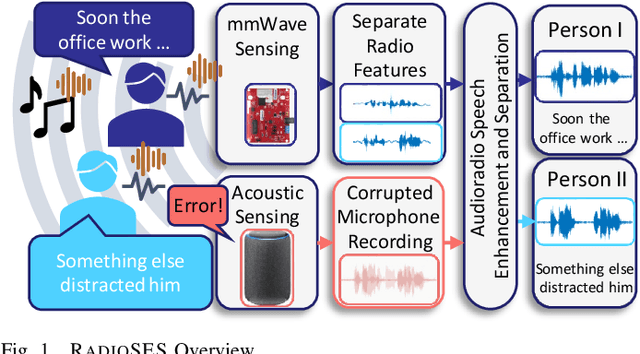
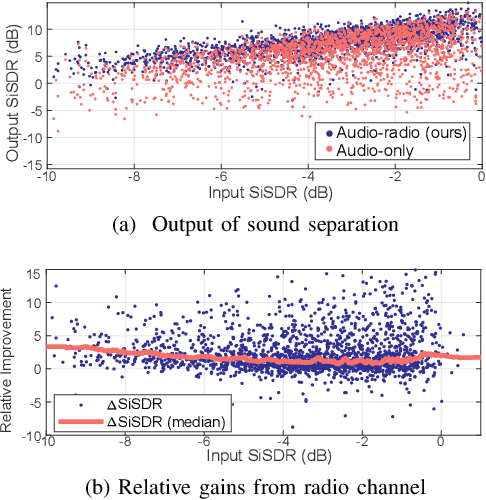

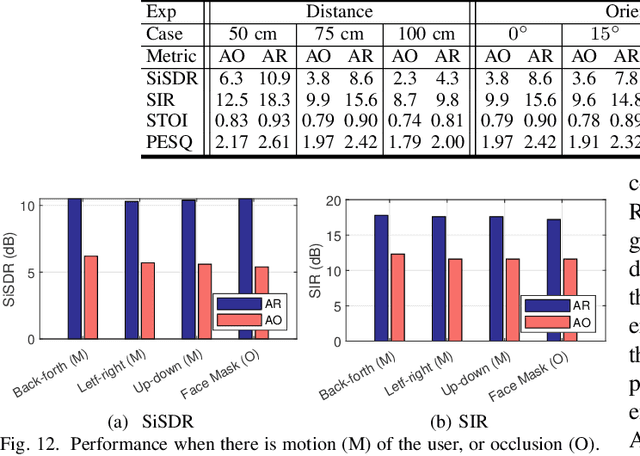
Abstract:Speech enhancement and separation have been a long-standing problem, especially with the recent advances using a single microphone. Although microphones perform well in constrained settings, their performance for speech separation decreases in noisy conditions. In this work, we propose RadioSES, an audioradio speech enhancement and separation system that overcomes inherent problems in audio-only systems. By fusing a complementary radio modality, RadioSES can estimate the number of speakers, solve source association problem, separate and enhance noisy mixture speeches, and improve both intelligibility and perceptual quality. We perform millimeter-wave sensing to detect and localize speakers, and introduce an audioradio deep learning framework to fuse the separate radio features with the mixed audio features. Extensive experiments using commercial off-the-shelf devices show that RadioSES outperforms a variety of state-of-the-art baselines, with consistent performance gains in different environmental settings. Compared with the audiovisual methods, RadioSES provides similar improvements (e.g., ~3 dB gains in SiSDR), along with the benefits of lower computational complexity and being less privacy concerning.
RadioMic: Sound Sensing via mmWave Signals
Aug 06, 2021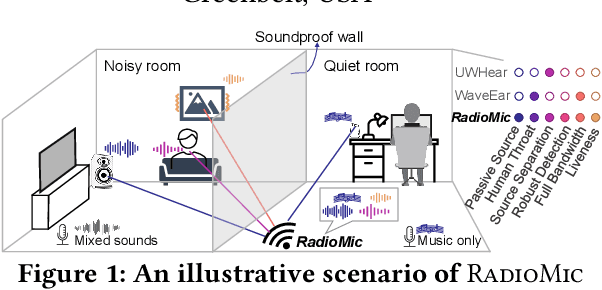
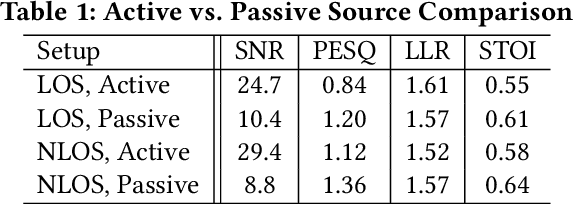
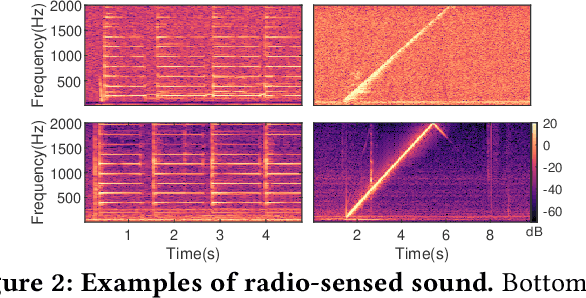

Abstract:Voice interfaces has become an integral part of our lives, with the proliferation of smart devices. Today, IoT devices mainly rely on microphones to sense sound. Microphones, however, have fundamental limitations, such as weak source separation, limited range in the presence of acoustic insulation, and being prone to multiple side-channel attacks. In this paper, we propose RadioMic, a radio-based sound sensing system to mitigate these issues and enrich sound applications. RadioMic constructs sound based on tiny vibrations on active sources (e.g., a speaker or human throat) or object surfaces (e.g., paper bag), and can work through walls, even a soundproof one. To convert the extremely weak sound vibration in the radio signals into sound signals, RadioMic introduces radio acoustics, and presents training-free approaches for robust sound detection and high-fidelity sound recovery. It then exploits a neural network to further enhance the recovered sound by expanding the recoverable frequencies and reducing the noises. RadioMic translates massive online audios to synthesized data to train the network, and thus minimizes the need of RF data. We thoroughly evaluate RadioMic under different scenarios using a commodity mmWave radar. The results show RadioMic outperforms the state-of-the-art systems significantly. We believe RadioMic provides new horizons for sound sensing and inspires attractive sensing capabilities of mmWave sensing devices
 Add to Chrome
Add to Chrome Add to Firefox
Add to Firefox Add to Edge
Add to Edge